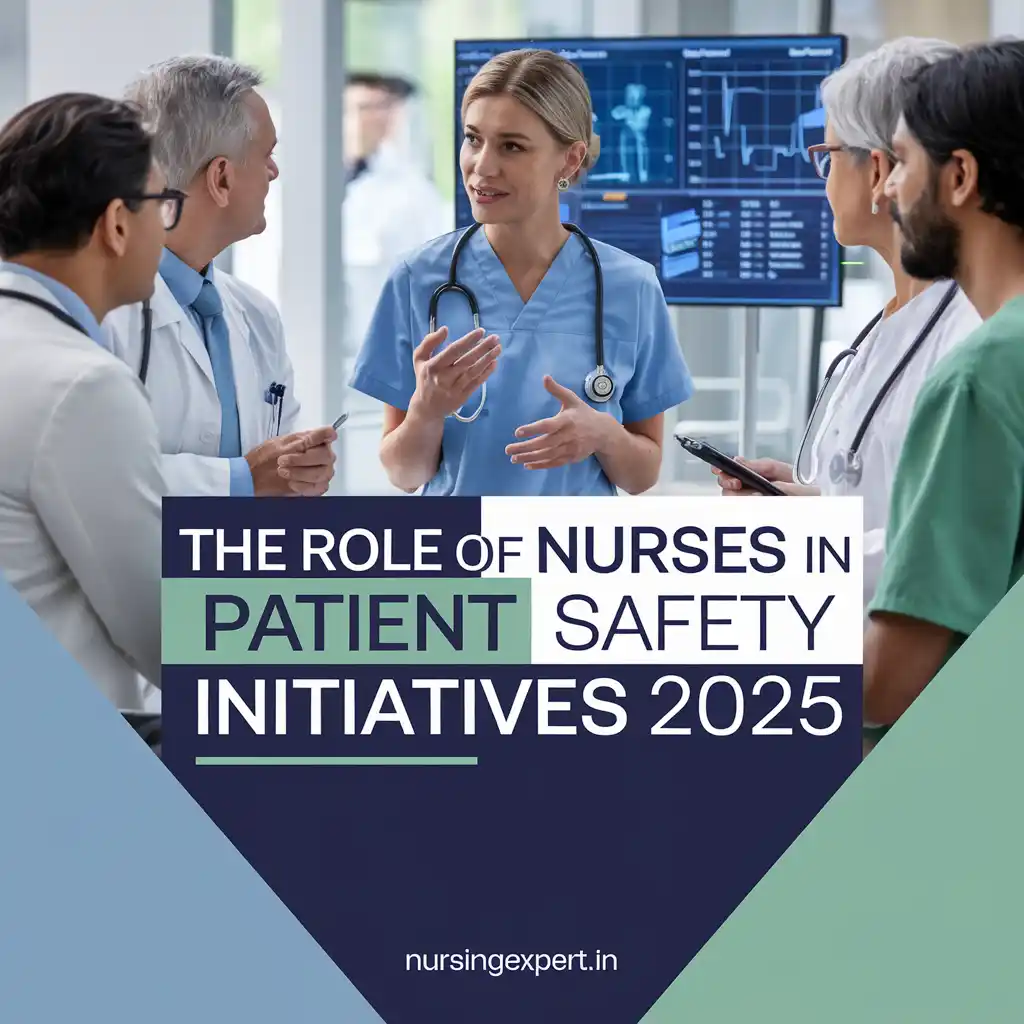Patient safety remains at the forefront of quality healthcare delivery, and nurses play a pivotal role in ensuring that every patient receives safe, effective, and high-quality care. In 2025, as healthcare systems continue to evolve and become more complex, nurses are increasingly taking on leadership roles in patient safety initiatives. Their responsibilities extend beyond direct patient care to include education, advocacy, and active participation in systemic improvements. By embracing innovative tools, fostering interdisciplinary collaboration, and continuously engaging in quality improvement, nurses help to reduce errors, prevent adverse events, and create a culture where patient safety is everyone’s priority.
Thank you for reading this post, don't forget to subscribe!
Introduction
In today’s healthcare environment, patient safety is more than avoiding errors—it’s about creating a system that anticipates risks and proactively addresses potential issues. Nurses, often the first point of contact in patient care, have the unique vantage point needed to detect safety concerns, advocate for safer practices, and implement improvements that benefit both patients and the healthcare team.


As we progress through 2025, nurses are working in an era defined by digital transformation, data-driven decision-making, and interdisciplinary teamwork. In this context, the role of nurses in patient safety initiatives is critical. They bridge the gap between clinical expertise and systemic innovation, using their hands-on experience and compassionate approach to create safer, more resilient healthcare environments.
This article explores the evolving role of nurses in patient safety initiatives, outlining key strategies, challenges, and future trends. We will examine how nurses contribute to safety through direct patient care, education, interprofessional collaboration, and leadership within quality improvement frameworks.
Understanding Patient Safety
a. Defining Patient Safety
Patient safety refers to the prevention of errors and adverse effects associated with healthcare delivery. It encompasses a range of practices designed to minimize harm to patients, including the implementation of evidence-based protocols, robust monitoring systems, and continuous quality improvement efforts. Key elements include:
- Error Prevention: Developing systems that reduce the likelihood of mistakes.
- Early Detection: Timely identification of potential adverse events.
- Risk Management: Proactively addressing factors that contribute to patient harm.
b. The Significance of Patient Safety
Improving patient safety is crucial for several reasons:
- Reducing Adverse Events: Fewer errors mean lower rates of hospital-acquired infections, medication mishaps, and surgical complications.
- Enhancing Patient Outcomes: When care is safe, patients have better recovery trajectories, reduced complications, and overall improved satisfaction.
- Cost Efficiency: Reducing errors and adverse events decreases the cost burden on healthcare systems by minimizing additional treatments, legal issues, and extended hospital stays.
- Building Trust: A strong commitment to patient safety enhances trust between patients and healthcare providers, leading to better communication and more effective care.
The Evolving Role of Nurses in Patient Safety
Nurses are central to achieving patient safety in modern healthcare. Their role has expanded to incorporate elements of direct patient care, quality improvement, education, and leadership.
a. Direct Patient Care and Vigilance
- Continuous Monitoring: Nurses closely observe patients and monitor vital signs, allowing them to detect early signs of distress or deterioration.
- Accurate Documentation: Detailed record-keeping is essential for tracking patient progress and identifying patterns that may indicate safety risks.
- Timely Interventions: Quick decision-making based on real-time assessments helps prevent escalation of potential problems.
- Safe Medication Administration: Nurses play a key role in ensuring correct medication dosing and administration, a critical component of patient safety.
b. Patient Education and Empowerment
- Clear Communication: Nurses educate patients about their conditions, treatment plans, and ways to minimize risks, ensuring patients understand how to participate in their own care.
- Teach-Back Methods: Confirming that patients understand the information provided through simple feedback techniques enhances comprehension and adherence.
- Education Materials: Providing resources such as brochures, videos, and interactive digital content helps patients learn at their own pace, reinforcing safe practices.
c. Interdisciplinary Collaboration
- Team-Based Care: Nurses work as part of interdisciplinary teams, collaborating with physicians, pharmacists, therapists, and others to develop and implement patient safety initiatives.
- Shared Decision-Making: Collaborating with colleagues to ensure that all facets of patient care are coordinated helps prevent errors that arise from communication gaps.
- Regular Meetings and Huddles: Scheduled team meetings allow for the exchange of information regarding patient safety, helping to promptly address emerging issues.
- Integrated Health Records: Utilizing unified electronic health records (EHRs) facilitates seamless information sharing among providers, ensuring that everyone is aware of a patient’s safety needs.
d. Leadership in Quality Improvement
- Quality Improvement Projects: Nurses often lead initiatives aimed at improving care processes and reducing errors. Participation in these projects not only enhances patient safety but also fosters professional growth.
- Data-Driven Practices: Nurses use data analytics to assess outcomes, identify areas for improvement, and implement evidence-based changes in practice.
- Advocacy: Acting as patient advocates, nurses promote policies and procedures that prioritize safety at both the organizational and systemic levels.
- Mentorship: Experienced nurses mentor newer colleagues in best practices for patient safety, creating a culture of continuous improvement.
Strategies for Enhancing Patient Safety
To achieve a high standard of patient safety, nurses can implement several best practices and strategies.
a. Standardizing Communication
- Structured Communication Tools: Utilize standardized protocols like SBAR (Situation, Background, Assessment, Recommendation) to ensure clear, concise communication between team members.
- Interdisciplinary Rounds: Regular rounds that include all members of the care team help facilitate real-time communication and coordinated decision-making.
- Consistent Documentation: Ensure that patient records are accurate and updated in real time to avoid miscommunication and duplication of efforts.
b. Implementing Evidence-Based Protocols
- Clinical Guidelines: Adhere to established clinical guidelines and protocols that are designed to reduce variability and prevent errors.
- Checklists: Use checklists for procedures such as medication administration, surgical safety, and patient transfers to ensure that no steps are missed.
- Simulation Training: Engage in regular simulation-based training exercises to practice high-risk scenarios in a controlled, safe environment.
c. Leveraging Technology
- Electronic Health Records: Use integrated EHR systems for real-time data collection and sharing to monitor patient safety effectively.
- AI and Data Analytics: Employ AI-driven tools to analyze patient data and identify potential risks before they become critical.
- Telehealth and Remote Monitoring: Expand telehealth services to monitor patients in real time, allowing for early interventions and reducing the risk of complications.
d. Continuous Education and Professional Development
- Ongoing Training: Regularly update staff on new safety protocols, technological tools, and evidence-based practices through workshops and online courses.
- Interdisciplinary Learning: Participate in joint training sessions with professionals from other disciplines to promote a unified approach to patient safety.
- Certifications and Specializations: Encourage nurses to pursue advanced certifications in patient safety and quality improvement to enhance their leadership skills in this area.
e. Fostering a Culture of Safety
- Open Communication: Create an environment where staff feel comfortable reporting errors and near-misses without fear of retribution.
- Supportive Leadership: Leaders must champion patient safety initiatives, providing the necessary resources and support to frontline staff.
- Feedback Mechanisms: Implement systems for collecting and analyzing feedback from both patients and staff to continuously refine safety practices.
- Recognition Programs: Celebrate successes and recognize staff contributions to promoting patient safety, reinforcing the importance of a collective commitment.
Addressing Challenges in Patient Safety
Despite the progress, several challenges continue to impede patient safety initiatives. Understanding and addressing these challenges is critical for sustainable improvement.
a. Resource Limitations
- Staffing Shortages: High patient-to-nurse ratios can compromise safety by increasing the likelihood of errors and reducing time for patient care.
- Financial Constraints: Limited budgets may restrict the implementation of advanced safety technologies and training programs.
- Time Pressures: Heavy workloads and administrative demands can leave little time for thorough safety checks and quality improvement activities.
b. Resistance to Change
- Cultural Barriers: Shifting from traditional methods to new, technology-driven approaches can face resistance from staff accustomed to established protocols.
- Overcoming Inertia: Resistance to new practices can be mitigated through education, demonstration of benefits, and gradual implementation.
c. Technological Challenges
- Integration Issues: Merging new technologies with existing systems (like EHRs) can be complex.
- User Adoption: Ensuring that all staff are comfortable and proficient with new technological tools requires ongoing training and support.
- Data Security: Protecting patient data in a digital environment is paramount and requires robust cybersecurity measures.
Future Trends in Patient Safety
a. AI and Predictive Analytics
- Real-Time Data Monitoring: AI tools will continue to advance, offering real-time monitoring of patient data, which allows for the early detection of complications.
- Predictive Models: Data analytics will predict potential safety issues before they occur, allowing nurses to intervene proactively.
- Personalized Interventions: AI will help tailor safety protocols to individual patient needs, enhancing personalized care.
b. Integration of Wearable Technology
- Continuous Monitoring: Wearable devices will further enhance patient safety by providing continuous, real-time data on vital signs and other health metrics.
- Responsive Alerts: Automated alerts will notify nurses immediately when a patient’s condition begins to deteriorate, ensuring timely intervention.
c. Enhanced Interdisciplinary Collaboration
- Digital Communication Tools: Virtual meeting platforms and integrated EHRs will facilitate even closer collaboration among healthcare teams.
- Shared Learning and Best Practices: Global and interdepartmental knowledge-sharing initiatives will drive continuous improvements in patient safety.
- Collaborative Quality Improvement: More integrated, team-based approaches will lead to standardized safety protocols and enhanced overall care.
d. Policy and Organizational Support
- Updated Guidelines: Ongoing revisions to standards and policies will further embed patient safety into every aspect of care.
- Increased Funding: Better funding mechanisms will support the adoption of advanced safety technologies and educational initiatives.
- Regulatory Innovations: Policymakers will continue to refine regulations that prioritize patient safety and quality care.
Frequently Asked Questions (FAQs)
Q1: What is patient safety, and why is it important?
A: Patient safety involves preventing errors and adverse effects associated with healthcare delivery. It is crucial because it improves outcomes, reduces complications, and builds trust in the healthcare system.
Q2: How do nurse staffing ratios affect patient safety?
A: Optimal nurse staffing ratios ensure that nurses have the time and resources to provide thorough, attentive care, reducing errors and improving patient outcomes.
Q3: What are some effective strategies for promoting patient safety?
A: Strategies include standardized communication protocols, evidence-based checklists, simulation-based training, leveraging digital tools, and fostering a culture of open communication and continuous improvement.
Q4: How can technology improve patient safety?
A: Integrated electronic health records (EHRs), AI-driven analytics, wearable devices, and telehealth platforms enable real-time monitoring and data sharing, enhancing early detection of issues and timely interventions.
Q5: What role do interdisciplinary teams play in patient safety?
A: Interdisciplinary teams ensure comprehensive care by bringing together different expertise. This collaboration reduces errors, enhances decision-making, and ensures coordinated care transitions.
Q6: What challenges exist in ensuring patient safety, and how can they be overcome?
A: Challenges include staffing shortages, resistance to change, technological integration, and data security. Overcoming these challenges requires education, improved communication, robust leadership, and the adoption of advanced technologies.
Q7: What future trends are shaping patient safety initiatives?
A: Future trends include more advanced AI and predictive analytics, expanded use of wearable technology, enhanced interdisciplinary collaboration, and stronger policy support to drive continuous quality improvement.
Conclusion
Patient safety is a cornerstone of quality healthcare, and in 2025, nurses are at the forefront of ensuring that care is both safe and effective. Through direct patient care, patient education, technology integration, and interdisciplinary collaboration, nurses help create environments where errors are minimized and outcomes are maximized. The journey to achieving optimal patient safety is ongoing, marked by both challenges and remarkable opportunities for growth.
Nurses’ dedication to patient-centered care, combined with their willingness to adopt new technologies and embrace collaborative approaches, is transforming healthcare. As we move into the future, continued advancements in AI, digital tools, and teamwork will further elevate the standard of patient safety, ensuring that every patient receives the highest quality of care.
By remaining committed to ongoing education, advocating for policy changes, and leveraging innovative strategies, nurses will continue to play a pivotal role in fostering a culture of safety and excellence in healthcare—one that ultimately benefits patients, providers, and the entire healthcare system.
References and Sources
- American Nurses Association (ANA). (2023). Patient Safety and Quality Improvement in Nursing. Retrieved from https://www.nursingworld.org
- Institute for Healthcare Improvement (IHI). (2022). Improving Patient Safety Through Teamwork. Retrieved from https://www.ihi.org
- Centers for Medicare & Medicaid Services (CMS). (2024). Value-Based Purchasing and Patient Safety. Retrieved from https://www.cms.gov
- Journal of Nursing Administration. (2023). Best Practices in Patient Safety. Retrieved from https://journals.lww.com/jna
- Peer-reviewed articles from the International Journal of Nursing Studies and Health Affairs.
- Additional resources from the World Health Organization (WHO) and recent policy briefs on patient safety.


